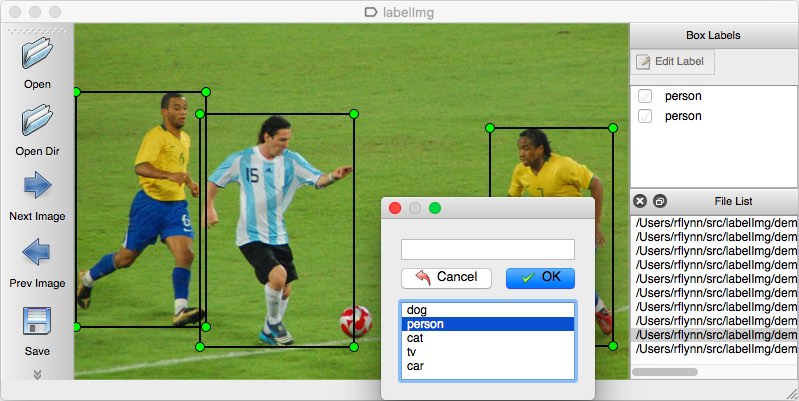LabelImg


LabelImg is a graphical image annotation tool.
It is written in Python and uses Qt for its graphical interface.
Annotations are saved as XML files in PASCAL VOC format, the format used by ImageNet.
Installation
Download prebuilt binaries
- Windows & Linux
- macOS. Binaries for macOS are not yet available. Help would be appreciated. At present, it must be built from source.
Build from source
Linux/Ubuntu/Mac requires at least Python 2.6 and has been tested with PyQt 4.8.
Ubuntu Linux
Python 2 + Qt4
sudo apt-get install pyqt4-dev-tools sudo pip install lxml make qt4py2 python labelImg.py python labelImg.py [IMAGE_PATH] [PRE-DEFINED CLASS FILE]
Python 3 + Qt5
sudo apt-get install pyqt5-dev-tools sudo pip3 install lxml make qt5py3 python3 labelImg.py python3 labelImg.py [IMAGE_PATH] [PRE-DEFINED CLASS FILE]
macOS
Python 2 + Qt4
brew install qt qt4 brew install libxml2 make qt4py2 python labelImg.py python labelImg.py [IMAGE_PATH] [PRE-DEFINED CLASS FILE]
Python 3 + Qt5 (Works on macOS High Sierra)
brew install qt # will install qt-5.x.x brew install libxml2 make qt5py3 python labelImg.py python labelImg.py [IMAGE_PATH] [PRE-DEFINED CLASS FILE]
Windows
Download and setup Python 2.6 or later, PyQt4 and install lxml.
Open cmd and go to labelImg directory
pyrcc4 -o resources.py resources.qrc python labelImg.py python labelImg.py [IMAGE_PATH] [PRE-DEFINED CLASS FILE]
Get from PyPI
pip install labelImg labelImg labelImg [IMAGE_PATH] [PRE-DEFINED CLASS FILE]
I tested pip on Ubuntu 14.04 and 16.04. However, I didn't test pip on macOS and Windows
Use Docker
docker run -it \ --user $(id -u) \ -e DISPLAY=unix$DISPLAY \ --workdir=$(pwd) \ --volume="/home/$USER:/home/$USER" \ --volume="/etc/group:/etc/group:ro" \ --volume="/etc/passwd:/etc/passwd:ro" \ --volume="/etc/shadow:/etc/shadow:ro" \ --volume="/etc/sudoers.d:/etc/sudoers.d:ro" \ -v /tmp/.X11-unix:/tmp/.X11-unix \ tzutalin/py2qt4 make qt4py2;./labelImg.py
You can pull the image which has all of the installed and required dependencies. Watch a demo video
Usage
Steps
- Build and launch using the instructions above.
- Click 'Change default saved annotation folder' in Menu/File
- Click 'Open Dir'
- Click 'Create RectBox'
- Click and release left mouse to select a region to annotate the rect box
- You can use right mouse to drag the rect box to copy or move it
The annotation will be saved to the folder you specify.
You can refer to the below hotkeys to speed up your workflow.
Annotate 3D-Bounding Box
After an image is opened click 'Create 3D Box'.
First you have to decide if a vehicle you want to annotate goes to the viewer or from.
Now click, move and release left mouse button to select a rectangled region just like for 2D-BB annotation but with one little addition: if a vehicle goes to the viewer your move must be top down, otherwise bottom up. You can choose whether to move from left to right or vice versa, but it is highly reccomended to try to select the whole object with the rectangled region.
After the release, 3D-BB is created automatically. Points of it now are set by default based on selected region.
Now you can drag points of the 3D-BB independent from each other in order to make your annotation more perspective correct.
The front of a 3D-BB is highlighted in blue to help distinguish the direction of motion.
Create pre-defined classes
You can edit the data/predefined_classes.txt to load pre-defined classes
Hotkeys
| Ctrl + u | Load all of the images from a directory |
| Ctrl + r | Change the default annotation target dir |
| Ctrl + s | Save |
| Ctrl + d | Copy the current label and rect box |
| Space | Flag the current image as verified |
| w | Create a rect box |
| d | Next image |
| a | Previous image |
| del | Delete the selected rect box |
| Ctrl++ | Zoom in |
| Ctrl-- | Zoom out |
| ↑→↓← | Keyboard arrows to move selected rect box |
How to contribute
Send a pull request
License
Citation: Tzutalin. LabelImg. Git code (2015). https://github.com/tzutalin/labelImg
Related
- ImageNet Utils to download image, create a label text for machine learning, etc
- Use Docker to run labelImg
- Generating the PASCAL VOC TFRecord files

